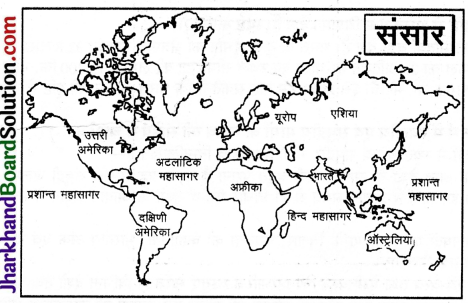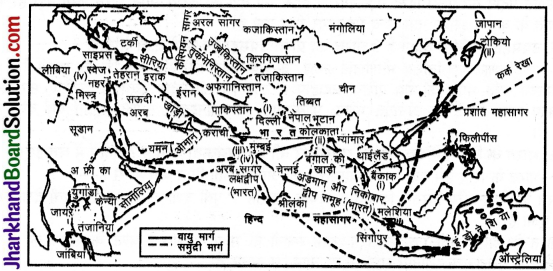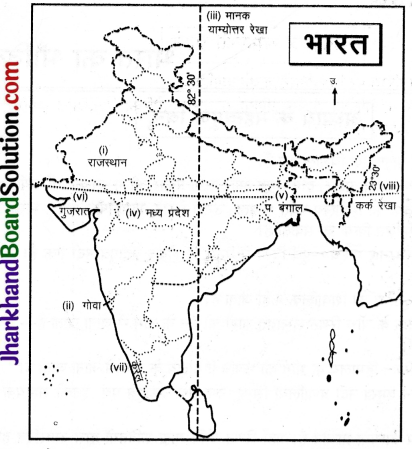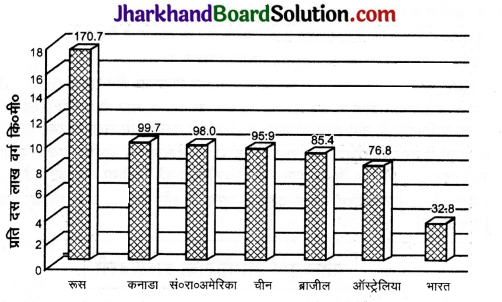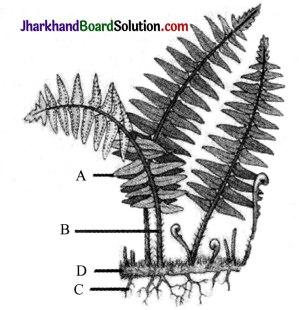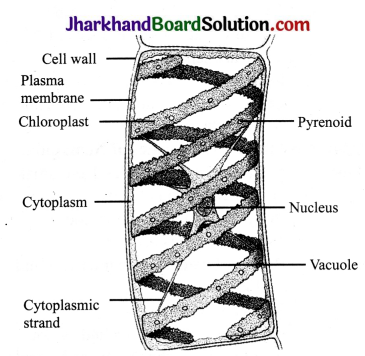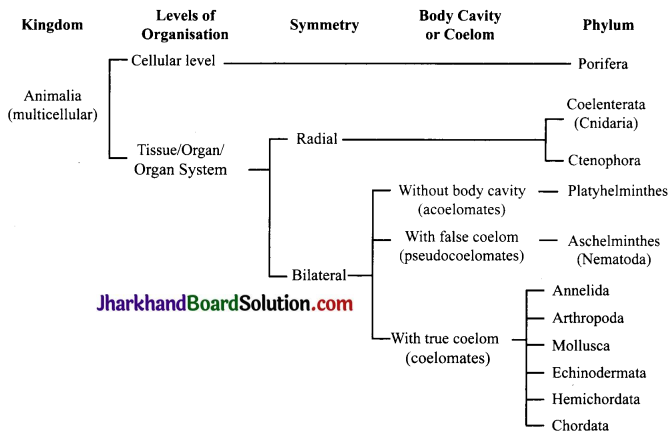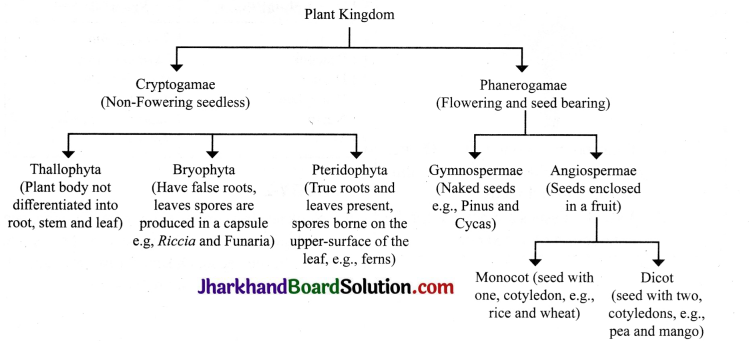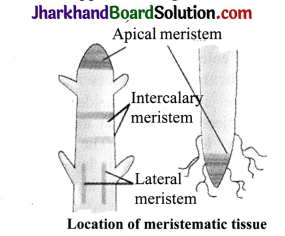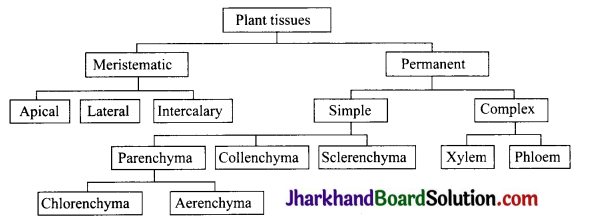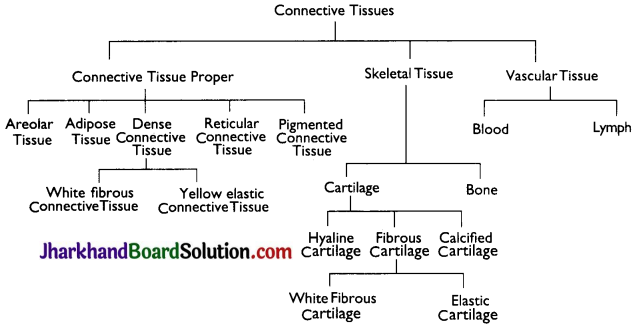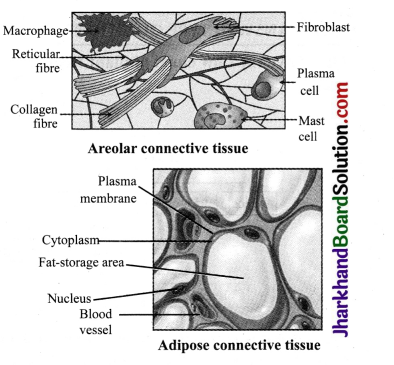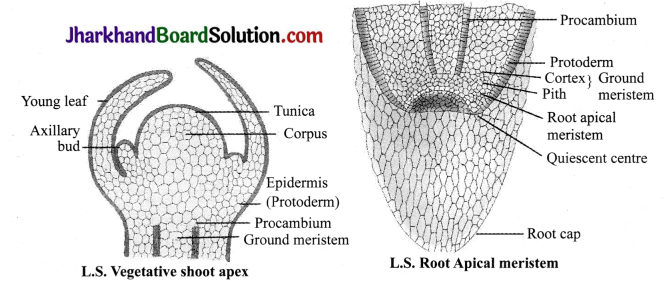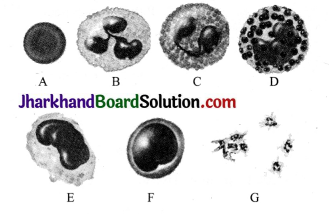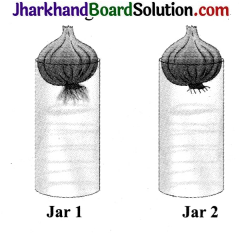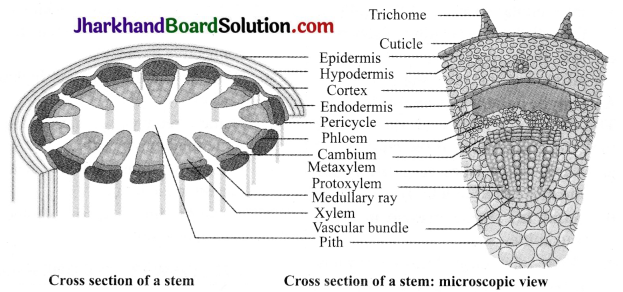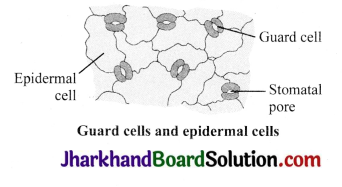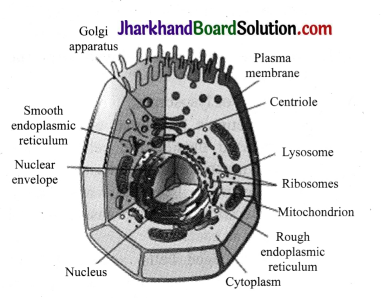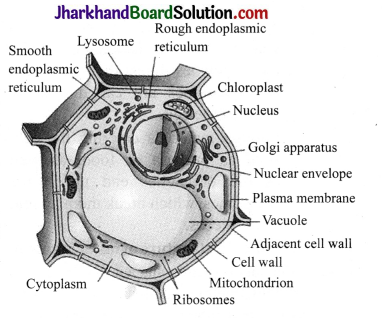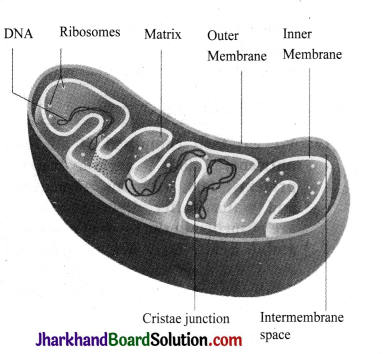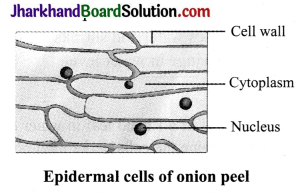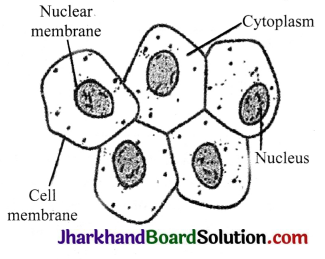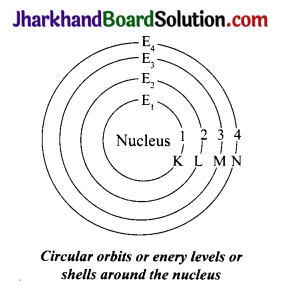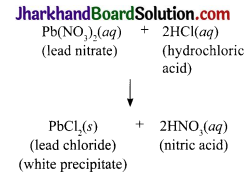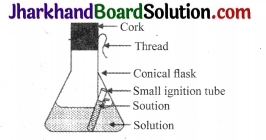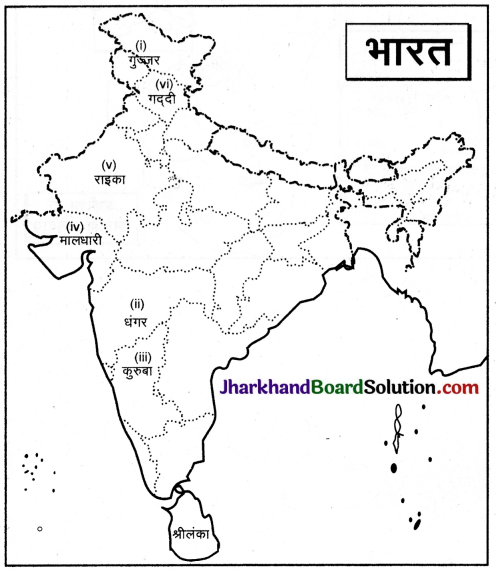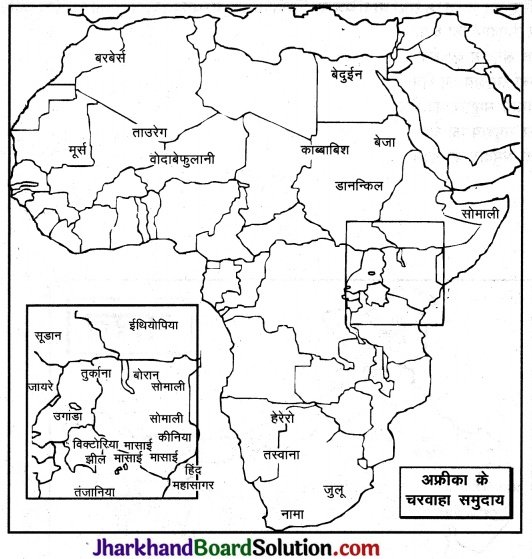Jharkhand Board JAC Class 9 Sanskrit Solutions Shemushi Chapter 5 सूक्तिमौक्तिकम् Textbook Exercise Questions and Answers.
JAC Board Class 9th Sanskrit Solutions Shemushi Chapter 5 सूक्तिमौक्तिकम्
JAC Class 9th Sanskrit सूक्तिमौक्तिकम् Textbook Questions and Answers
प्रश्न 1.
एकपदेन उत्तरं लिखत-(एक शब्द में उत्तर लिखिए-)
(क) वित्ततः क्षीणः कीदृशः भवति? (धन से क्षीण कैसा होता है?)
उत्तरम् :
अक्षीणः (क्षय रहित)।
(ख) कस्य प्रतिकूलानि कार्याणि परेषां न समाचरेत्? (किसके प्रतिकूल कार्य दूसरों के साथ न करें?)
उत्तरम् :
आत्मनः (अपने)।
(ग) कुत्र दरिद्रता न भवेत् ? (कहाँ दरिद्रता नहीं होनी चाहिए?)
उत्तरम् :
मधुर वचने (मीठा बोलने में।)
![]()
(घ) वृक्षाः स्वयं कानि न खादन्ति? (वृक्ष स्वयं क्या नहीं खाते?)
उत्तरम् :
फलानि। (फलों को)
(ङ) का पुरा लध्वी भवति? (पहले छोटी क्या होती है?)
उत्तरम् :
सज्जनानां मैत्री (सज्जनों की दोस्ती)।
प्रश्न 2.
अधोलिखितप्रश्नानाम् उत्तराणि संस्कृतभाषया लिखत –
(निम्नलिखित प्रश्नों के उत्तर संस्कृत भाषा में लिखिए-)
(क) यलेन किं रक्षेत् वित्तं वृत्तं वा? (प्रयत्नपूर्वक किसकी रक्षा करनी चाहिए वित्त की या वृत्त की?)
उत्तरम् :
यत्नेन वृत्तं रक्षेत्। (प्रयत्नपूर्वक आचरण/ चरित्र की रक्षा करनी चाहिए।)
(ख) अस्माभिः (किं न समाचरेतोकीदृशम् आचरणं न कर्तव्यम्? (हमें कैसा आचरण नहीं करना चाहिए?) ।
उत्तरम् :
आत्मनः प्रतिकूलानि परेषां न समाचरेत्। (जैसा हमें अपने लिए पसन्द न हो, वैसा आचरण दूसरों के साथ नहीं करना चाहिए।)
(ग) जन्तवः केन तुष्यन्ति? (प्राणी किस से सन्तुष्ट होते हैं?)
उत्तरम :
जन्तवः प्रियवाक्यप्रदानेन तष्यन्ति। (प्राणी प्रिय वचन बोलने से सन्तष्ट होते हैं।)
(घ) सज्जनानां मैत्री कीदृशी भवति? (सज्जनों की मित्रता किस प्रकार की होती है?)
उत्तरम् :
सज्जनानां मैत्री दिनस्य परार्द्धस्य छायेव पुरा लध्वी पश्चात् च वृद्धिमती भवति।
(सज्जनों की मित्रता दिन के मध्याहन की (दोपहर के बाद) छाया के समान पहले छोटी और बाद में बढ़ने वाली होती है।)
![]()
(ङ) सरोवराणां हानिः कदा भवति? (सरोवरों की हानि कब होती है?)
उत्तरम् :
यदा मरालैः सह सरोवराणां विप्रयोगः भवति तदा सरोवराणां हानिः भवति।
(जब हंसों के साथ सरोवरों का वियोग होता है, तब सरोवरों की हानि होती है।)
प्रश्न 3.
‘क’ स्तम्भे विशेषणानि ‘ख’ स्तम्भे च विशेष्याणि दत्तानि, तानि यथोचितं योजयत
(‘क’ स्तम्भ में विशेषण और ‘ख’ स्तम्भ में विशेष्य दिये गये हैं, उनको यथोचित मिलाइये-)
| ‘क’ स्तम्भः | ‘ख’ स्तम्भः |
| (क) आस्वाद्यतोयाः | 1. खलानां मैत्री |
| (ख) गुणयुक्तः | 2. सज्जनानां मैत्री |
| (ग) दिनस्य पूर्वार्द्धभिन्ना | 3. नद्यः |
| (घ) दिनस्य परार्द्धभिन्ना | 4. दरिद्रः |
उत्तरम् :
| ‘क’ स्तम्भः | ‘ख’ स्तम्भः |
| (क) आस्वाद्यतोयाः | 3. नद्यः |
| (ख) गुणयुक्तः | 4. दरिद्रः |
| (ग) दिनस्य पूर्वार्द्धभिन्ना | 1. खलानां मैत्री |
| (घ) दिनस्य परार्द्धभिन्ना | 2. सज्जनानां मैत्री |
![]()
प्रश्न 4.
अधोलिखितयोः श्लोकद्वयोः आशयं हिन्दीभाषया आङ्ग्लभाषया वा लिखत
(निम्नलिखित दोनों श्लोकों का आशय हिन्दी भाषा में अथवा अंग्रेजी भाषा में लिखिए-)
(क) आरम्भगुर्वी क्षयिणी क्रमेण
लघ्वी पुरा वृद्धिमती च पश्चात्।
दिनस्य पूर्वार्द्धपरार्द्धभिन्ना
छायेव मैत्री खलसज्जनानाम्॥
उत्तरम् :
हिन्दी-आशय – दुर्जनों और सज्जनों की मित्रता पूर्वार्द्ध और परार्द्ध में दिन की छाया के समान भिन्न होती है। जिस प्रकार मध्याह्न से पहले छाया आरम्भ में बड़ी होती है और बाद में क्रमशः कम होती जाती है, उसी प्रकार दुर्जनों की मित्रता आरम्भ में प्रगाढ़ होती है और फिर शनैः-शनैः कम होकर समाप्त हो जाती है। मध्याह्न के समय छाया सबसे कम अर्थात् नहीं के बराबर होती है, इसके पश्चात् वह क्रमशः वृद्धि को प्राप्त होती है और सायंकाल को उसकी लम्बाई. अनन्त होती है। इसी प्रकार सज्जनों की मित्रता मध्याह्न के पश्चात् की छाया के समान आरम्भ में कम और बाद में क्रमशः प्रगाढ़ होती जाती है। उनकी यह मित्रता अनन्त अर्थात् कभी न समाप्त होने वाली होती है।
(ख) प्रियवाक्यप्रदानेन सर्वे तुष्यन्ति जन्तवः।
तस्माद् तदेव वक्तव्यं वचने का दरिद्रता॥
उत्तरम् :
हिन्दी-आशय – इस संसार में जितने भी प्राणी हैं, चाहे वे पशु-पक्षी हों अथवा मानव, सभी मधुर वचनों को सुनकर अत्यन्त प्रसन्न और सन्तुष्ट होते हैं। अत: व्यक्ति को सदैव ही प्रिय अर्थात् मधुर वचनों का प्रयोग करना चाहिए। भला वैसे वचन बोलने में भी क्या कंजूसी, जिनसे सारा संसार सन्तुष्ट होता है। अर्थात् व्यक्ति को कटु वचनों के स्थान पर सदैव मधुर वचनों का ही प्रयोग करना चाहिए, क्योंकि मधुर वचनों का प्रयोग करने से उसके मान-सम्मान और यश में वृद्धि होती है, हानि किसी प्रकार की नहीं होती। फिर ऐसे वचन बोलने में कंजूसी करना तो मूर्खता ही है।
प्रश्न 5.
अधोलिखितपदेभ्यः भिन्न प्रकृतिकं पदं चित्वा लिखत – (निम्नलिखित पदों में से भिन्न प्रकृति के पद चुनकर लिखिए-)
(क) वक्तव्यम्, कर्त्तव्यम्, सर्वस्वम्, हन्तव्यम्।
(ख) यत्नेन, वचने, प्रियवाक्यप्रदानेन, मरालेन।
(ग) श्रूयताम्, अवधार्यताम्, धनवताम्, क्षम्यताम्।
(घ) जन्तवः, नद्यः, विभूतयः, परितः।
उत्तरम् :
(क) सर्वस्वम्
(ख) वचने
(ग) धनवताम्
(घ) परितः।
![]()
प्रश्न 6.
स्थूलपदान्यधिकृत्य प्रश्ननिर्माणं कुरुत –
(मोटे छपे पदों को आधार बनाकर प्रश्न निर्माण कीजिए-)
(क) वृत्ततः क्षीणः हतः भवति।
(ख) धर्मसर्वस्वं श्रुत्वा अवधार्यताम्।
(ग) वृक्षाः फलं न खादन्ति।
(घ) खलानां मैत्री आरम्भगुर्वी भवति।
उत्तरम् :
प्रश्न:-कस्मात् क्षीणः हतः भवति?
प्रश्न:-किं श्रुत्वा अवधार्यताम्?
प्रश्न:-के फलं न खादन्ति?
प्रश्न:-केषां मैत्री आरम्भगुर्वी भवति?
प्रश्न 7.
अधोलिखितानि वाक्यानि लोट्लकारे परिवर्तयत –
(निम्नलिखित वाक्यों को लोट्लकार में परिवर्तित कीजिए-)
यथा-स: पाठं पठति। सः पाठं पठतु।
(क) नद्यः आस्वाद्यतोयाः सन्ति। – ……………..
(ख) स: सदैव प्रियवाक्यं वदति। – ……………..
(ग) त्वं परेषां प्रतिकूलानि न समाचरसि। – ……………..
(घ) ते वृत्तं यत्नेन संरक्षन्ति। – ……………..
(ङ) अहं परोपकाराय कार्यं करोमि। – ……………..
उत्तरम् :
(क) नद्यः आस्वाद्यतोयाः सन्तु।
(ख) सः सदैव प्रियवाक्यं वदतु।
(ग) त्वं परेषां प्रतिकूलानि न समाचर।
(घ) ते वृत्तं यत्नेन संरक्षन्तु।
(ङ) अहं परोपकाराय कार्य करवाणि।
JAC Class 9th Sanskrit सूक्तिमौक्तिकम् Important Questions and Answers
प्रश्न: 1.
वित्तस्य प्रवृत्तिः का अस्ति? (धन की प्रवृत्ति क्या है?)
उत्तरम् :
वित्तस्य प्रवृत्तिः अस्ति यत् इदम् एति च याति च। (धन की प्रवृत्ति है कि यह आता है और चला जाता है।)
प्रश्न: 2.
वित्ततः क्षीणः मनुष्यः कथं भवति? (धन के क्षीण होने पर मनुष्य कैसा होता है?)
उत्तरम् :
वित्ततः क्षीणः मनुष्यः अक्षीणः भवति। (धन के क्षीण होने पर मनुष्य अक्षीण होता है।)
![]()
प्रश्न: 3.
वृत्ततः क्षीणः मनुष्यः कथं भवति? (चरित्र/आचरण के क्षीण होने पर मनुष्य कैसा होता है?)
उत्तरम् :
वृत्ततः क्षीणः मनुष्यः हतो हतः। (चरित्र/आचरण के क्षीण होने पर मनुष्य मरा हुआ है।)
प्रश्न: 4.
वृत्तं कथं संरक्षेत्? (चरित्र/आचरण की कैसे रक्षा करनी चाहिए?)
उत्तरम् :
वृत्तं यत्नेन संरक्षेत्। (चरित्र/आचरण की प्रयत्नपूर्वक रक्षा करनी चाहिए।)
प्रश्नः 5.
किंकत्वा किम अवधार्यताम? (क्या करके क्या धारण करना चाहिए?)
उत्तरम् :
धर्मसर्वस्वं श्रुत्वा तम् अवधार्यताम्। (धर्म अर्थात् कर्त्तव्य के सार को सुनकर उसे धारण करना चाहिए।)
प्रश्नः 6.
प्रियवाक्यप्रदानेन किं भवति? (प्रिय वचन बोलने से क्या होता है?)
उत्तरम् :
प्रियवाक्यप्रदानेन सर्वे जन्तवः तुष्यन्ति ।(प्रिय वचन बोलने से सभी प्राणी सन्तुष्ट होते हैं।)
प्रश्न: 7.
कस्मिन् विषये दरिद्रता न कर्तव्या? (किस विषय में कंजूसी नहीं करनी चाहिए?)
उत्तरम् :
प्रियवचने दरिद्रता न कर्तव्या। (प्रिय वचनों में कंजूसी नहीं करनी चाहिए।)
![]()
प्रश्न: 8.
नद्यः किं न कुर्वन्ति? (नदियाँ क्या नहीं करती हैं ?)
उत्तरम् :
नद्यः स्वयमेव अम्भः न पिबन्ति। (नदियाँ स्वयं ही (अपने) जल को नहीं पीती हैं।)
प्रश्न: 9.
वृक्षाः किं न कुर्वन्ति? (वृक्ष क्या नहीं करते हैं ?)
उत्तरम् :
वृक्षाः स्वयं फलानि न खादन्ति। (वृक्ष स्वयं (अपने) फलों को नहीं खाते हैं।)
प्रश्नः 10.
सस्यं खलु के न अदन्ति? (अन्न को निश्चय ही कौन नहीं खाते हैं ?)
उत्तरम् :
सस्यं खलु वारिवाहाः न अदन्ति। (अन्न को निश्चय ही मेघ नहीं खाते हैं।)
प्रश्न: 11.
केषां विभूतयः परोपकाराय भवन्ति? (किनकी सम्पत्तियाँ परोपकार के लिए होती हैं?)
उत्तरम् :
सतां विभूतयः परोपकाराय भवन्ति। (सज्जनों की सम्पत्तियाँ परोपकार के लिए होती हैं।)
![]()
प्रश्न: 12.
पुरुषैः सदा किमर्थं प्रयत्नः कर्तव्यः? (पुरुषों को सदा किसलिए प्रयत्न करना चाहिए?)
उत्तरम् :
पुरुषैः सदा गुणेषु एव प्रयत्नः कर्तव्यः। (पुरुषों को सदैव गुणों को धारण करने में प्रयत्न करना चाहिए।)
प्रश्न: 13.
कः अगुणैः ईश्वरैः समः न? (कौन गुणहीन धनवानों के समान नहीं है?)
उत्तरम् :
गुणयुक्तः दरिद्रः अपि अगुणैः ईश्वरैः समः न। (गुणयुक्त निर्धन भी गुणहीन धनवानों के बराबर नहीं होता, अपितु गुणहीन धनवानों से श्रेष्ठ होता है।)
प्रश्न: 14.
खलानां मैत्री कीदृशी भवति? (दुर्जनों की मित्रता कैसी होती है?)
उत्तरम् :
खलानां मैत्री आरम्भगुर्वी पश्चात् च क्रमेण क्षयिणी भवति। (दुर्जनों की मित्रता प्रारम्भ में बढ़ने वाली और बाद में क्रमशः कम होने वाली होती है।)
प्रश्न: 15.
अत्र महीमण्डलमण्डनोपकरणाः के कथिताः? (यहाँ पर पृथ्वी की शोभा बढ़ाने वाले किन्हें कहा गया है?)
उत्तरम् :
अत्र महीमण्डलमण्डनोपकरणाः हंसाः कथिताः। (यहाँ पृथ्वी की शोभा बढ़ाने वाले हंसों को कहा गया है।)
प्रश्न: 16.
गुणाः कदा गुणाः भवन्ति? (गुण कब गुण होते हैं?)
उत्तरम् :
गुणाः यदा गुणेषु निवसन्ति तदा गुणाः भवन्ति। (गुण जब गुणी पुरुष में रहते हैं तब गुण होते हैं।)
प्रश्न: 17.
गुणाः कदा दोषाः भवन्ति? (गुण कब दोष हो जाते हैं?)
उत्तरम् :
गुणाः निर्गुणं प्राप्य दोषाः भवन्ति। (गुण निर्गुणी पुरुष में पहुँचकर दोष हो जाते हैं।)
![]()
स्थूलाक्षराणि आधृत्य प्रश्ननिर्माणं कुरुत-(रेखांकित अक्षर वाले शब्दों के आधार पर प्रश्ननिर्माण कीजिए-)
प्रश्न: 1.
वृत्तं यत्नेन रक्षेत। (वृत्त की यत्नपूर्वक रक्षा करनी चाहिए।)
उत्तरम् :
किम् यत्नेन रक्षेत्? (यत्नपूर्वक किसकी रक्षा करनी चाहिए।)
प्रश्न: 2.
अक्षीणो वित्ततः क्षीणः। (धन से क्षीण अक्षीण होता है।)
उत्तरम् :
कस्मात् क्षीणः अक्षीणः? (किससे क्षीण अक्षीण है?)
प्रश्न: 3.
आत्मनः प्रतिकूलानि परेषां न समाचरेत्। (अपने प्रतिकूल दूसरों के साथ आचरण नहीं करना चाहिए।)
उत्तरम् :
परेषां कानि न समाचरेत् ? (दूसरों के साथ क्या आचरण नहीं करना चाहिए?)
प्रश्न: 4.
प्रियवाक्यप्रदानेन सर्वे तुष्यन्ति जन्तवः। (प्रिय वाणी बोलने से सभी प्राणी सन्तुष्ट हो जाते हैं।)
उत्तरम् :
केन सर्वे तुष्यन्ति जन्तवः? (सभी प्राणी किससे सन्तुष्ट होते हैं?)
![]()
प्रश्नः 5.
पिबन्ति नद्यः स्वयमेव नाभ्यः। (नदियाँ स्वयं पानी नहीं पीती।)
उत्तरम् :
काः स्वयमेव अम्भः न पिबन्ति। (कौन स्वयं पानी नहीं पीर्ती?)
प्रश्नः 6.
स्वयं न खादन्ति फलानि वृक्षाः। (वृक्ष स्वयं फल नहीं खाते हैं।)
उत्तरम् :
वृक्षाः स्वयं कानि न खादन्ति? (वृक्ष स्वयं क्या नहीं खाते हैं? )
प्रश्नः 7.
नादन्ति सस्यं वारिवाहा। (बादल फसल नहीं खाते।)
उत्तरम् :
वारिवाहाः किम् न अदन्ति ? (बादल क्या न खाते हैं?)
प्रश्न: 8.
परोपकाराय सतां विभूतयः। (सज्जनों का वैभव परोपकार के लिए होता है।)
उत्तरम् :
सतां विभूतयः कस्मै भवति? (सज्जनों का वैभव किसके लिए होता है?)
प्रश्न: 9.
गुणेषु एव कर्तव्यः प्रयत्नः पुरुषैः सदा। (पुरुषों को सदा गुणों में ही प्रयत्नशील होना चाहिए।)
उत्तरम् :
पुरुषे सदा केषु एव प्रयत्नः कर्त्तव्यः? (पुरुषों को किनमें प्रयत्न करना चाहिए?)
![]()
प्रश्नः 10.
निर्गुणं प्राप्य गुणाः दोषा भवन्ति। (गुणहीन को प्राप्त कर गुण दोष हो जाते हैं।)
उत्तरम् :
कम् प्राप्य गुणाः दोषा भवन्ति? (किसको प्राप्त कर गुण दोष हो जाते हैं ?)
परियोजनाकार्यम्
(क) परोपकारविषयकं श्लोकद्वयम् अन्विष्य स्मृत्वा च कक्षायां सस्वरं पठ।
(परोपकार सम्बन्धी दो श्लोक ढूँढ़कर और याद करके कक्षा में स्वर सहित पढ़िए।)
उत्तरम् :
(1) अष्टादशपुराणेषु व्यासस्य वचनद्वयम्।
परोपकारः पुण्याय पापाय परपीडनम्॥
हिन्दी-आशय – अठारह पुराणों में व्यास जी के दो वचन (ही) हैं। दूसरों की भलाई पुण्य के लिये और दूसरों को पीड़ा पाप के लिए है।
(2) परोपकाराय फलन्ति वृक्षाः परोपकाराय वहन्ति नद्यः।
परोपकाराय दुहन्ति गावः परोपकाराय इदं शरीरम्॥
हिन्दी-आशय – वृक्ष दूसरों की भलाई के लिए फल देते हैं, नदियाँ दूसरों की भलाई के लिए बहती हैं। गायें दूसरों की भलाई के लिए दूध देती हैं, यह शरीर (भी) दूसरों की भलाई के लिए (ही) है।
(ख) नद्याः एकं सुन्दरं चित्रं निर्माय संकलय्य वा वर्णयत यत् तस्याः तीरे मनुष्याः, पशवः खगाश्च निर्विघ्नं जलं पिबन्ति।
(नदी का एक सुन्दर चित्र बनाकर अथवा संकलन करके वर्णन कीजिए कि उसके किनारे पर मनुष्य, पशु और पक्षी निर्विघ्न जल पीते हैं।)
उत्तर :
छात्र स्वयं करें।
![]()
भावविस्तारः
(क) आस्वाद्यतोयाः प्रवहन्ति नद्यः समुद्रमासाद्य भवन्त्यपेयाः।
खारे समुद्र में मिलने पर स्वादिष्ट जल वाली नदियों का जल अपेय (खारा) हो जाता है। इसी भावसाम्य के आधार पर कहा गया है कि “संसर्गजाः दोषगुणाः भवन्ति।” अर्थात् संगति से (ही) दोष और गुण उत्पन्न होते हैं। ।
(ख) छायेव मैत्री खलसज्जनानाम्।
दुष्ट व्यक्ति मित्रता करता है और सज्जन व्यक्ति भी मित्रता करता है। परन्तु दोनों की मैत्री, दिन के पूर्वार्द्ध एवं परार्द्ध की छाया की भाँति भिन्न-भिन्न होती है। वास्तव में दुष्ट व्यक्ति की मैत्री के लिए श्लोक का प्रथम चरण “आरम्भगुर्वी क्षयिणी क्रमेण” (प्रारम्भ में बढ़ने वाली और बाद में कम होने वाली) कहा गया है तथा सज्जन की मैत्री के लिए द्वितीय चरण ‘लध्वीपुरा वृद्धिमती च पश्चात्’ (पहले लघु रूप वाली और बाद में बढ़ी हुई रूप वाली)कहा गया है।
भाषिकविस्तारः
1. वित्ततः – वित्त शब्द से तसिल प्रत्यय किया गया है। पंचमी विभक्ति के अर्थ में लगने वाले तसिल प्रत्यय का तः (तस् = तः) ही शेष रहता है। उदाहरणार्थ – सागर + तसिल = सागरतः, प्रयाग + तसिल = प्रयागतः, देहली + तसिल = देहलीतः आदि । इसी प्रकार वृत्ततः शब्द में भी तसिल प्रत्यय लगा करके वृत्ततः शब्द बनाया गया है।
समाचरेत् – सम् + आङ् (आङ्-आ) + चर् + विधिलिङ् + प्रथम पुरुष + एकवचन।
तुष्यन्ति – तुष् + लट्लकार + प्रथमपुरुष + बहुवचन।
संरक्षेत् – सम् + रक्ष् + विधिलिङ् + प्रथमपुरुष + एकवचन।
हतः – हन् + क्त प्रत्यय (पुल्लिङ्ग प्र. वि. ए. व.)
![]()
2. उपसर्ग – क्रिया के पूर्व जुड़ने वाले प्र, परा आदि शब्दों को उपसर्ग कहा जाता है। इन उपसर्गों के जुड़ने से क्रिया के अर्थ में परिवर्तन आ जाता है।
जैसे – ‘ह’ धातु से उपसर्गों का योग होने पर निम्नलिखित रूप बनते हैं –
प्र + हृ = प्रहरति, प्रहार (हमला करना)
वि + है = विहरति, विहार (भ्रमण करना)
उप + ह = उपहरति, उपहार (भेंट देना) .
सम् + ह = संहरति, संहार (मारना)
3. शब्दों को स्त्रीलिङ्ग में परिवर्तित करने के लिए स्त्री प्रत्यय का प्रयोग किया जाता है। इन प्रत्ययों में टाप व डीप मुख्य हैं। ‘टाप्’ में से ट् और प् का लोप होन पर ‘आ’ शेष रहता है। ‘डीप’ में से ङ् और प् का लोप होने पर ‘ई’ शेष रहती है।
जैसे – बाल + टाप् (आ) = बाला
अध्यापक + टाप् (आ) = अध्यापिका
लघु + ङीप् (ई) = लघ्वी
गुरु + ङीप् (ई) = गुर्वी।
साधु + ङीप् (ई) = साध्वी।
सूक्तिमौक्तिकम् Summary and Translation in Hindi
पाठका सारांश – संस्कृत-साहित्य के नीति-ग्रन्थों में सारगर्भित और अत्यन्त सरल रूप में नैतिक शिक्षायें दी जाती रही। हैं, जिससे मनुष्य अपने जीवन में उन शिक्षाओं पर अमल करते हुए अपने जीवन को सफल और समृद्ध बना सकता है। ऐसे ही मनोहारी और दुर्लभ वचन सुभाषित रूप में यहाँ संकलित हैं। पहले सुभाषित में सदाचार की महत्ता बताते हुए। कहा गया है कि हमें अपने आचरण को पवित्र बनाये रखना चाहिए।
धन तो आता है और चला जाता है, धन के क्षीण होने पर कुछ भी क्षीण नहीं होता लेकिन आचरण के नष्ट हो जाने पर सब कुछ नष्ट हो जाता है। दूसरे सुभाषित में कहा गया है कि स्वयं के प्रतिकूल आचरण को दूसरों के साथ नहीं करना चाहिए। तीसरे सुभाषित में प्रिय वचन बोलने के महत्त्व को दर्शाया गया है।
चौथे सुभाषित में परोपकार करना सज्जनों का स्वभाव होता है, बताया। गया है। पाँचवें सुभाषित में सद्गुणों को ग्रहण करने का उपदेश दिया गया है। छठे सुभाषित में दुर्जनों और सज्जनों की मित्रता में भिन्नता बतायी गई है। सातवें और आठवें सुभाषितों में उत्तम पुरुष के सम्पर्क से होने वाली शोभा की प्रशंसा तथा सत्संग की महिमा का वर्णन किया है।
![]()
1. वृत्तं यत्नेन संरक्षेद् वित्तमेति च याति च।
अक्षीणो वित्ततः क्षीणो वृत्ततस्तु हतो हतः॥
शब्दार्थाः – वृत्तम् = आचरणम् (आचरण, चरित्र), यत्नेन = प्रयत्नपूर्वकं (प्रयत्नपूर्वक), संरक्षेत् = रक्षा कर्तव्या (रक्षा करनी चाहिए), वित्तम् = धनम् (धन/ ऐश्वर्य), एति = आगच्छति (आता है), च = और, याति = गच्छति (चला जाता है), वित्ततः = धनस्य (धन के), क्षीणः = नष्टे (नष्ट होने पर), अक्षीणः = न क्षीणः (नष्ट न हुआ), तु = तो, वृत्ततः = आचरणस्य (आचरण के / चरित्र के), क्षीणः = नष्टे (नष्ट होने पर), हतो हतः = पूर्णरूपेण क्षीणः (पूरी तरह नष्ट हुए के समान/मरे हुए के समान होता है)।
अन्वयः – वृत्तम् यत्नेन संरक्षेत् वित्तम् एति च याति च। वित्ततः क्षीण: अक्षीणः वृत्ततः तु क्षीणः हतः हतः। हिन्दी अनुवादः
सन्दर्भ – यह श्लोक हमारी पाठ्यपुस्तक ‘शेमुषी’ के ‘सूक्तिमौक्तिकम्’ नामक पाठ से अवतरित है। यह ‘मनुस्मृति’ से संकलित किया गया है।
प्रसंग – प्रस्तुत सुभाषित में सदाचार की महत्ता को बताया गया है। हिन्दी-अनुवाद – (मनुष्य को) आचरण की प्रयत्नपूर्वक रक्षा करनी चाहिए (धन की नहीं क्योंकि) धन तो आता है और चला जाता है। धन के नष्ट हो जाने पर (मानव का) कुछ भी नष्ट नहीं होता है, लेकिन चरित्र के नष्ट हो जाने पर (मानव) मरे हुए के समान होता है अर्थात् उसका सब कुछ नष्ट हो जाता है।
संस्कत व्यारव्याः
सन्दर्भ:-श्लोकोऽयम् अस्माकं ‘शेमुषी’ इति पाठ्यपुस्तकस्य’ ‘सूक्तमौक्तिकम्’ इति पाठात् उद्धृतः। श्लोकोऽयं मनुस्मृति तः सङ्कलितः। (यह श्लोक हमारी ‘शेमुषी’ पाठ्यपुस्तक के ‘सूक्तिमौक्तिकम्’ पाठ से लिया गया है। यह श्लोक मनुस्मृति से संकलित है।)
प्रसङ्गः – श्लोकेऽस्मिन् नीतिकारः सदाचारस्य महत्वं वर्णयन् कथयति। (इस श्लोक में नीतिकार सदाचार का महत्व वर्णन करते हुए कहता है।)
व्याख्याः -सदाचरणं स्वस्य चरित्रं वा तु प्रयासपूर्वकं रक्षणीयम् न च वित्तं धनं वा। यतः धनं तु आगच्छति गच्छति वा।
अतः धने क्षीणे तु अक्षय एव परञ्च नष्टे चरित्रे तु मानव: नश्यति एव। (सदाचार अथवा अपने चरित्र की तो प्रयत्नपूर्वक रक्षा करनी चाहिए, वित्त अथवा धन की नहीं, क्योंकि धन तो आता है जाता है अत: धन क्षीण होने पर भी अक्षय ही है, परन्तु चरित्र के नष्ट होने पर तो मान ही नष्ट हो जाता है।)
अवबोधन कार्यम्
प्रश्न 1.
एकपदेन उत्तरत- (एक शब्द में उत्तर दीजिए-)
(क) कं यत्नेन संरक्षेत्? (किसकी यत्नपूर्वक रक्षा करनी चाहिए?)
(ख) कस्मात् क्षीणः मानवः हतः? (किससे क्षीण हुआ मानव मारा जाता है?)
प्रश्न 2.
पूर्णवाक्येन उत्तरत- (पूरे वाक्य में उत्तर दीजिए-)
(क) वित्तं कीदृशं भवति? (वित्त कैसा होता है?).
(ख) वित्तवृत्तयोः को भेदः? (वित्त और वृत्त में क्या अन्तर है?)
प्रश्न 3. यथानिर्देशम् उत्तरत-(निर्देशानुसार उत्तर दीजिए-)
(क) ‘आगच्छति’ इति क्रियापदस्य स्थानेऽत्रं श्लोके किं पदं प्रयुक्तम्?
‘आगच्छति’ क्रियापद के स्थान पर श्लोक में क्या. शब्द प्रयोग किया है?)
(ख) कः मनुष्यः हतः? (कौन व्यक्ति मारा जाता है?)
उत्तराणि-
(1) (क) वृत्तम् (आचरणम्)।
(ख) वृत्ततः। (आचरण)।
(2) (क) वित्तः तु एति याति च। (धन तो आता है जाता है।)
(ख) अक्षीणे वित्ततः क्षीणो वृत्ततस्तु हतोहतः। (धन के नष्ट होने पर कुछ भी नष्ट नहीं होता परन्तु वृत्त के
क्षीण होने पर मरे हुए के समान होता है।)
(3) (क) एति (आता है)।
(ख) क्षीणवृत्तः (जिसका आचरण क्षीण हो गया हो)।
![]()
2. श्रूयतां धर्मसर्वस्वं श्रुत्वा चैवावधार्यताम्।
आत्मनः प्रतिकूलानि परेषां न समाचरेत्॥
शब्दार्था: – श्रूयताम् = आकर्ण्य (सुनो), धर्मसर्वस्वम् = कर्तव्यसारम् (धर्म के सार को), च = (और), श्रुत्वा = आकर्ण्य (सुनकर), एव = निश्चयेन (ही), अवधार्यताम् = धारणं कुरु (धारण करो), आत्मनः = स्वस्य (अपने), प्रतिकूलानि = विपरीतानि (अनुकूल नहीं है जो), परेषाम् = अन्येषां (दूसरों के साथ), न = मा (नहीं), समाचरेत् = व्यवहारं कर्तव्यम् (व्यवहार करना चाहिए)।
अन्वयः – धर्मसर्वस्वम् श्रूयताम् च एव अवधार्यताम्। आत्मनः प्रतिकूलानि परेषाम् न समाचरेत्।
हिन्दी अनुवादः
सन्दर्भ – यह श्लोक हमारी पाठ्यपुस्तक ‘शेमुषी’ के ‘सूक्तिमौक्तिकम्’ नामक पाठ से अवतरित है। यह ‘विदुरनीति’ से संकलित किया गया है।
प्रसंग – प्रस्तुत श्लोक में जो स्वयं को पसन्द न हो, ऐसा आचरण दूसरों के साथ न करने की सलाह दी गई है।
हिन्दी-अनुवाद – धर्म अर्थात् कर्तव्य के सार को सुनो और सुनकर (उसे व्यवहार में) धारण करना चाहिए। अपने विपरीत (अर्थात् जो आचरण या व्यवहार व्यक्ति को स्वयं के प्रति पसन्द न हो ऐसा आचरण) दूसरों के साथ व्यवहार में नहीं लाना चाहिए। आशय यह है कि व्यक्ति जिस कार्य अथवा आचरण को अपने लिए ठीक नहीं समझता, उसे वैसा आचरण दूसरों के साथ नहीं करना चाहिए।
संस्कत-व्यारव्याः
सन्दर्भ: – श्लोकोऽयम् अस्माकं ‘शेमुषी’ इति पाठ्यपुस्तकस्य ‘सूक्तिमौक्तिकम्’ इति पाठात् उद्धृत। श्लोकोऽयं च …. विदुर नीति ग्रन्थात् सङ्कलितः। (यह श्लोक हमारी ‘शेमुषी’ पाठ्य-पुस्तक के ‘सूक्तिमौक्तिकम्’ पाठ से उद्धृत है। यह श्लोक विदुर नीति ग्रन्थ से संकलित है।)
प्रसंग: – श्लोकेऽस्मिन् नीतिकारः विदुरः कथयति यत् यदाचरणं स्वस्य प्रतिकूलो भवति तन्न अन्येभ्यः सह आचरणीयम्।
निश्चितमेव धरणीय पुस्तकच याश्चादी स्वस्थ
(इस श्लोक में नीतिज्ञ विदुर कहता है कि जो आचरण अपने अनुकूल न हो उसका दूसरे के साथ आचरण नहीं करना चाहिए।)
व्याख्या: – सर्वेषां धर्माणां कर्त्तव्यानाम् च सम्यक् रूपेण आकर्ण्य निश्चितमेव धारणीयम् परञ्च यत् कार्यं स्वस्य प्रतिकूलं भवति तस्य अन्येभ्यः सह व्यवहारं न कर्त्तव्यम्। (सभी धर्मों और कर्तव्यों को अच्छी तरह सुनकर निश्चित ही धारण करना चाहिए, परन्तु जो कार्य स्वयं के प्रतिकूल होता है। वह दूसरों के साथ व्यवहार नहीं करना चाहिए।)
अवबोधन कार्यम्
प्रश्न 1.
एकपदेन उत्तरत- (एक शब्द में उत्तर दीजिए-),
(क) किं श्रूयताम् अवधार्यं च? (क्या सुनना और समझना चाहिए?)
(ख) गुत्वा कि करणीयम्? (धर्म-सर्वस्व को सुनकर क्या करना चाहिए?)
![]()
प्रश्न 2.
पूर्णवाक्येन उत्तरत- (पूरे वाक्य में उत्तर दीजिए-)
(क) परेषां कानि न समाचरेत् ? (किनका आचरण नहीं करना चाहिए?)
(ख) किम् अवधार्यम् ? (क्या धारण करना चाहिए?)
प्रश्न 3.
यथानिर्देशम् उत्तरत-(निर्देशानुसार उत्तर दीजिए-)
(क) ‘अनुकूलानि’ इति पदस्य विलोमपदं श्लोकात् चित्वा लिखत्।
(‘अनुकूलानि’ पद का विलोम पद श्लोक से चुनकर लिखिए।)
(ख) ‘आकर्ण्य’ इति पदस्य पर्यायवाचि पदं श्लोकात् चित्वा लिखत।
(‘आकर्ण्य’ पद का समानार्थी पद श्लोक से चुनकर लिखिए।)
उत्तराणि :
(1) (क) धर्म सर्वस्वम् (धर्म का सार)।
(ख) अवधारणीय (धारण करना चाहिए)।
(2) (क) आत्मनः प्रतिकूलानि परेषां न समाचरेत्। (अपने अनुकूल न हो उसको दूसरे के साथ व्यवहार नहीं करना चाहिए।)
(ख) श्रुतं धर्म सर्वस्वम् अवधार्य। (सुने धर्म के सार को धारण करना चाहिए।)
(3) (क) प्रतिकूलानि (विरुद्ध)।
(ख) श्रुत्वा (सुनकर)।
![]()
3. प्रियवाक्यप्रदानेन सर्वे तुष्यन्ति जन्तवः।
तस्माद् तदेव वक्तव्यं वचने का दरिद्रता॥
शब्दार्थाः – प्रियवाक्यप्रदानेन = स्नेहयुक्तेन भाषणेन (प्रिय वाक्य (वचन) बोलने से), सर्वे = समस्ताः (सभी), जन्तवः = प्राणिनः (प्राणी), तुष्यन्ति = सन्तुष्टाः भवन्ति (सन्तुष्ट होते हैं), तस्मात् = अतः (इसलिए), तदेव = असौ एव (वह ही, वैसे ही), वक्तव्यम् = भणितव्यं (बोलना चाहिए), वचने का दरिद्रता = कथने का दारिद्रयं (बोलने में क्या दरिद्रता अर्थात् कंजूसी)।
अन्वयः – प्रियवाक्यप्रदानेन सर्वे जन्तवः तुष्यन्ति। तस्मात् तदेव वक्तव्यम्, वचने का दरिद्रता।
हिन्दी अनुवादः
सन्दर्भ – यह श्लोक हमारी पाठ्यपुस्तक ‘शेमुषी’ के ‘सूक्तिमौक्तिकम्’ नामक पाठ से अवतरित है। यह ‘चाणक्यनीतिः’ से संकलित किया गया है।
प्रसंग – प्रस्तुत श्लोक में प्रियवचन बोलने का उपदेश दिया गया है।
हिन्दी-अनुवाद – प्रिय वाक्य (वचन) बोलने से सभी प्राणी सन्तुष्ट होते हैं अतः (व्यक्ति को) वैसे ही वचन बोलने चाहिए। वचनों में (बोलने में) क्या दरिद्रता अर्थात् मीठा बोलने में कंजूसी नहीं करनी चाहिए।
संस्कत-व्यारव्याः
सन्दर्भ: – श्लोकोऽयम् अस्माकं ‘शेमुषी’ इति पाठ्यपुस्तकस्य ‘सूक्तिमौक्तिकम्’ इति पाठात् उद्धृत। श्लोकोऽयं चाणक्य नीतिः ग्रन्थात् सङ्कलितः। (यह श्लोक हमारी ‘शेमुषी’ पाठ्य-पुस्तक के ‘सूक्तिमौक्तिकम्’ पाठ से उद्धृत है। यह श्लोक चाणक्य नीति ग्रन्थ से संकलित है।)
प्रसंग: – श्लोकेऽस्मिन् नीतिकारः चाणक्यः उपदिशति यत् मानवेन सदैव मधुरा वाणी एव प्रयोज्या। (इस श्लोक में नीतिकार चाणक्य उपदेश देता है कि मनुष्य को सदैव मधुर वाणी का ही प्रयोग करना चाहिए।)
व्याख्या: – स्नेहयुक्त मधुरवाण्या प्राणिनः सन्तुष्टा भवन्ति अनेनैव कारणेन सैव मधुरा वाणी वचनीयम्। यतः कथने किं दारिद्रयम् ? (स्नेह युक्त मधुर वाणी से सभी प्राणी सन्तुष्ट होते हैं। अतः डी अर्थात् मधुर वाणी ही बोलनी चाहिए क्योंकि कहने में क्या गरीबी आती है।)
अवबोधन कार्यम्
प्रश्न 1.
एकपदेन उत्तरत- (एक शब्द में उत्तर दीजिए-)
(क) जन्तवः केन तुष्यन्ति ? (प्राणी किससे सन्तुष्ट होते हैं?)
(ख) अतः किं वक्तव्यम्? (अत: क्या बोलना चाहिए?)
![]()
प्रश्न 2.
पूर्णवाक्येन उत्तरत- (पूरे वाक्य में उत्तर दीजिए-)
(क) सर्वे जन्तवः केन तुष्यन्ति ? (सभी जन्तु किससे सन्तुष्ट होते हैं ?)
(ख) प्रियवाक्यस्य का विशेषता? (प्रिय वचनों की क्या विशेषता है?)
प्रश्न 3.
यथानिर्देशम् उत्तरत-(निर्देशानुसार उत्तर दीजिए-)
(क) ‘प्राणिनः’ इति पदस्य समानार्थी पदं श्लोकात् लिखत। (‘प्राणिनः’ पद का समानार्थी पद श्लोक से लिखिए।)
(ख) ‘तस्मात् तदेव वक्तव्यम्’ अत्र ‘तदेव’ सर्वनाम पदं कस्य स्थाने प्रयुक्तम्।। – (तस्मात् तदेव वक्तव्यम्’ यहाँ तदेव’ सर्वनाम पद किसके स्थान पर प्रयोग किया है?)
उत्तराणि :
(1) (क) प्रियवाक्येन (प्रिय वचनों से)।
(ख) प्रिय वाक्यम् (मधुर वचन)।
(2) (क) सर्वे जन्तवः प्रियवाक्य प्रदानेन तुष्यन्ति। (सभी जन्तु प्रियवचन बोलने से सन्तुष्ट होते हैं।)
(ख) प्रियवाक्य वचने न कापि दरिद्रता। (प्रियवचन में कोई दरिद्रता नहीं होती।)
(3) (क) जन्तवः (जीव)।
(ख) प्रियवाक्यम् (मधुरवचन)।
![]()
4. पिबन्ति नद्यः स्वयमेव नाम्भः स्वयं न खादन्ति फलानि वृक्षाः।
नादन्ति सस्यं खल वारिवाहाः परोपकाराय सतां विभूतयः ॥
शब्दार्था: – नद्यः = सरितः (नदियाँ), स्वयमेव = आत्मना एव (स्वयं ही), अम्भः = जलम् (जल), न = मा (नहीं), पिबन्ति = पानं कुर्वन्ति (पीती हैं), वृक्षाः = तरवः (वृक्ष), स्वयम् = आत्मना (स्वयं), न फलानि = फलों को, न खादन्ति = न भक्ष्यन्ति (नहीं खाते हैं), वारिवाहाः = मेघाः (जलवहन करने वाले बादल), सस्यम् = अन्नम् (अन्न को, फसल को), खलु = निश्चयेन (निश्चित ही), न = मा (नहीं), अदन्ति = खादन्ति (खाते हैं), सताम् = सज्जनानां (सज्जनों की), विभूतयः = समृद्धिः (सम्पत्तियाँ), परोपकाराय = परेषाम् उपकाराय (परोपकार के लिए/ दूसरों के उपकार के लिए), भवन्ति = वर्तन्ते (होती हैं)।
अन्वयः – नद्यः स्वयमेव अम्भः न पिबन्ति, वृक्षाः (च) स्वयम् फलानि न खादन्ति । वारिवाहाः सस्यम् खलु न अदन्ति सताम् विभूतयः परोपकाराय। हिन्दी अनुवादः
सन्दर्भ – यह श्लोक हमारी पाठ्यपुस्तक ‘शेमुषी’ के ‘सूक्तिमौक्तिकम्’ नामक पाठ से अवतरित है। यह “सुभाषितरत्नभाण्डागारम्’ से सकलित किया गया है।
प्रसंग – प्रस्तुत श्लोक में सज्जनों का स्वभाव परोपकार करना ही होता है, बताया गया है।
हिन्दी-अनुवाद – नदियाँ अपना जल स्वयं नहीं पीती हैं (और) वृक्ष स्वयं (अपने) फलों को नहीं खाते हैं। मेघ (बादल) (अपने द्वारा उगाये गए) अन्नों को नहीं खाते हैं। निश्चय ही सज्जनों की सम्पत्तियाँ परोपकार के लिए होती हैं।
![]()
संस्कत-व्यारव्याः
सन्दर्भ:-श्लोकोऽयम् अस्माकं ‘शेमुषी’ इति पाठ्यपुस्तकस्य ‘सूक्तिमौक्तिकम्’ इति पाठात् उद्धृत। श्लोकोऽयं ‘सुभाषितरत्न-भांडागारम्’ इति ग्रन्थात् सङ्कलितः। (यह श्लोक हमारी ‘शेमुषी’ पाठ्य-पुस्तक के ‘सूक्तिमौक्तिकम्’ पाठ से उद्धृत है। यह श्लोक ‘सुभाषित-रत्नभांडागारम्’ ग्रन्थ से संकलित है।)
प्रसंग: – श्लोकेऽस्मिन् कवि कथयति यत् ‘परेषामुपकारं करणीयम्’ इत्येव सज्जनानां स्वभावः भवति। (इस श्लोक में कवि कहता है कि ‘परोपकार करना चाहिए’ यह सज्जनों का स्वभाव ही होता है।)
व्याख्या: – सरितः आत्मनः जलं न पानं कुर्वन्ति। तरवः अपि आत्मनः फलानि न अदति भक्षयन्ति वा। वारिदाः (मेघाः) निश्चितमेव अन्नं न खादन्ति। (अनेन स्पष्ट) यत् सज्जनानां समृद्धिः परेषाम् उपकाराय एव भवति। (नदियाँ अपना जल नहीं पीती हैं, वृक्ष अपने फल नहीं खाते हैं, मेघ निश्चित ही अन्न नहीं खाते हैं। उससे स्पष्ट है कि सज्जनों की समृद्धि दूसरों के उपकार के लिए ही होती है।)
अवबोधन कार्यम्
प्रश्न 1.
एकपदेन उत्तरत- (एक शब्द में उत्तर दीजिए-)
(क) स्वाम्भः का: न पिबन्ति? (अपना पानी कौन नहीं पीती हैं।)
(ख) वृक्षाः किं न खादन्ति ? (वृक्ष क्या नहीं खाते?)
प्रश्न 2.
पूर्णवाक्येन उत्तरत- (पूरे वाक्य में उत्तर दीजिए-)
(क) सतां विभूतयः कस्मै भवन्ति? (सज्जनों का वैभव किसलिए होता है?)
(ख) वारिवाहाः किं न खादन्ति? (बादल क्या नहीं खाते?)
![]()
प्रश्न 3.
यथानिर्देशम् उत्तरत-(निर्देशानुसार उत्तर दीजिए-)
(क) ‘खादन्ति’ इति क्रियापदस्य स्थाने श्लोके किं पदं प्रयुक्तम्?
(‘खादन्ति’ क्रियापद के स्थान पर श्लोक में किस पद का प्रयोग किया गया है?)
(ख) ‘पिबन्ति’ पदे मूल धातुं लिखत। (‘पिबन्ति’ पद में मूल धातु लिखिए।)
उत्तराणि :
(1) (क) नद्यः (नदियाँ)।
(ख) सस्यम् (फसल को)।
(2) (क) सतां विभूतयः परोपकाराय भवन्ति। (सज्जनों का वैभव परोपकार के लिए होता है।)
(ख) वारिवाहा सस्यं नादन्ति। (बादल फसल नहीं खाते।)
(3) (क) अदन्ति (खाते हैं)।
(ख) पा (पीना)।
5. गुणेष्वेव हि कर्तव्यः प्रयत्नः पुरुषैः सदा।
गुणयुक्तो दरिद्रोऽपि नेश्वरैरगुणैः समः॥
शब्दार्थाः – पुरुषैः = मानवैः (पुरुषों/ मानवों के द्वारा), सदा = सर्वदा (हमेशा/ सदैव), गुणेषु एव = सद्गुणेषु एव (गुणों को धारण करने में ही, प्रयत्नः = प्रयत्न, कर्तव्यः = करणीयः (करना चाहिए), गुणयुक्तः = गुणसम्पन्नः (गुणों से युक्त), दरिद्रः अपि = धनहीनोऽपि (निर्धन व्यक्ति भी), अगुणैः = गुणों से हीन, ईश्वरैः = श्रीयुक्तैः (ऐश्वर्यवानों से/ ६ नवानों से), समः = तुल्यः अस्ति (समान/बराबर है)।
अन्वयः – पुरुषैः सदा गुणेषु एव प्रयत्नः कर्तव्यः हि गुणयुक्तः दरिद्रः अपि न अगुणैः ईश्वरैः समः।
हिन्दी अनुवादः
सन्दर्भ – यह श्लोक हमारी पाठ्यपुस्तक ‘शेमुषी’ के ‘सूक्तिमौक्तिकम्’ नामक पाठ से अवतरित है। यह ‘मृच्छकटिकम्’
से संकलित किया गया है।
प्रसंग – प्रस्तुत श्लोक में गुणों की महिमा को बताते हुए कहा गया है कि गुणवान् व्यक्ति निर्धन होते हुए भी गुणहीन धनवान् से श्रेष्ठ होता है।
हिन्दी-अनुवाद – मनुष्यों को सदैव ही गुणों को धारण करने में प्रयत्नशील रहना चाहिए क्योंकि संसार में गुणों से युक्त निर्धन व्यक्ति भी गुणों से हीन धनवान् के बराबर नहीं होता अपितु उससे श्रेष्ठ होता है। अर्थात् गुणों से युक्त निर्धन व्यक्ति गुणहीन धनवान् से श्रेष्ठ होता है।
![]()
संस्कत-व्याख्याः
सन्दर्भ: – श्लोकोऽयम् अस्माकं ‘शेमुषी’ इति पाठ्यपुस्तकस्य ‘सूक्तिमौक्तिकम्’ इति पाठात् उद्धृत। श्लोकोऽयं महाकवि शूद्रक-विरचितात् ‘मृच्छकटिकम्’ नाटकात् सङ्कलितः। (यह श्लोक हमारी ‘शेमुषी’ पाठ्य-पुस्तक के ‘सूक्तिमौक्तिकम्’ पाठ से उद्धृत है। यह श्लोक मूलतः महाकवि शूद्रक विरचितं ‘मृच्छकटिक’ नामक नाटक-ग्रन्थ से संकलित है।)
प्रसंग: – श्लोकेऽस्मिन् गुणानां महिमा वर्णिता। अत एव गुणवान् मानवः निर्धनोऽपि सन् निर्गुणात् धनवतः श्रेष्ठतर; भवति। (इस श्लोक में गुणों की महिमा वर्णित है। अतएव गुणवान् मानव निर्धन होते हुए भी निर्गुण (गुणहीन) धनवान से अच्छा होता है।)
व्याख्याः – मानवै सदैव सद्गुणेषु एव प्रयत्नं (प्रयासं) करणीयम् (यतः) गुण सम्पन्नः धनहीनोऽपि सन् गुणहीनेन् समः (तुल्या) एव भवति। (मानव को सदैव अच्छे गुणों में ही प्रयत्नशील होना चाहिए क्योंकि गुण सम्पन्न धनहीन व्यक्ति भी गुणहीन धनवान के समान होता है।)
अवबोधन कार्यम्
प्रश्न 1.
एकपदेन उत्तरत – (एक शब्द में उत्तर दीजिए-)
(क) केषु प्रयत्नः कर्त्तव्यः? (किनमें प्रयत्न करना चाहिए?)
(ख) गुणयुक्त दरिद्रस्य गुणहीन धनिकस्य च मध्ये कः श्रेष्ठः? (गुणयुक्त दरिद्र से गुणहीन धनी में कौन श्रेष्ठ है?)
प्रश्न 2.
पूर्णवाक्येन उत्तरत- (पूरे वाक्य में उत्तर दीजिए-)
(क) पुरुषैः सदैव केषु प्रयत्न: करणीयः? (पुरुषों द्वारा किसमें प्रयत्न किया जाना चाहिए?)
(ख) को मनुष्यः श्रेष्ठतरः? (कौन व्यक्ति अधिक अच्छा है?)
प्रश्न 3.
यथानिर्देशम् उत्तरत-(निर्देशानुसार उत्तर दीजिए-)
(क) ‘करणीयः’ इति क्रियापदस्य पर्यायवाचिपदं श्लोकात् चित्वा लिखत्।
(‘करणीयः’ क्रिया का समानार्थी पद श्लोक से लिखिए।)
(ख) ‘विषमः’ इति पदस्य विलोमपदं श्लोकात् चित्वा लिखत।
(‘विषमः’ पद का विलोम श्लोक से चुनकर लिखिए।)
उत्तराणि :
(1) (क) गुणेषु (गुणों में)।
(ख) गुणयुक्त दरिद्रः (गुणी गरीब)।
(2) (क) पुरुषैः सदैव गुणेषु एव प्रयत्नः करणीयः। (मनुष्यों को सदा गुण अर्जित करने में प्रयत्न करना चाहिए।)
(ख) गुणयुक्तोऽपि निर्धनः श्रेष्ठः भवति। (गुणों से युक्त भी गरीब व्यक्ति श्रेष्ठ होता है।)
(3) (क) कर्त्तव्यः (करना चाहिए)।
(ख) समः (समान)।
![]()
6. आरम्भगुर्वी क्षयिणी क्रमेण लघ्वी पुरा वृद्धिमती च पश्चात्।
दिनस्य पूर्वार्द्धपरार्द्धभिन्ना छायेव मैत्री ख़लसज्जनानाम्॥
शब्दार्थाः – आरम्भगुर्वी = आदौ दीर्घा (आरम्भ में लम्बी), क्रमेण = क्रमशः (लगातार, धीरे-धीरे), क्षयिणी = क्षयशीला (घटने वाली), पुरा = प्रारम्भे (पहले), च = और, लध्वी = अल्पा (कम), पश्चात् = अनन्तरम् (पश्चात्), वृद्धिमती = वृद्धिं प्राप्ता (लम्बी होती हुई /लम्बी हुई), दिनस्य = दिवसस्य (दिन के), पूर्वार्द्ध = दोपहर के पहले, परार्द्ध = दोपहर के बाद, भिन्ना = इतरा (अलग होती है), छाया = छाया, इव = समा (समान), खलानाम् = दुष्टानां (दुष्टों की), सज्जनानाम् = सताम् (सज्जनों की), मैत्री = सख्यं (मित्रता)।
अन्वयः – आरम्भगुर्वी क्रमेण क्षयिणी पुरा च लघ्वी पश्चात् (च) वृद्धिमती दिनस्य पूर्वार्द्धपरार्द्धभिन्ना छाया इव खलसज्जनानाम् मैत्री (भवति)।
सन्दर्भ – यह श्लोक हमारी पाठ्यपुस्तक ‘शेमुषी’ के ‘सूक्तिमौक्तिकम्’ नामक पाठ से अवतरित है। यह ‘नीतिशतकम्’ से संकलित किया गया है।
प्रसंग – प्रस्तुत श्लोक में दुष्टों और सज्जनों की मित्रता की भिन्नता का वर्णन किया गया है।
हिन्दी-अनुवाद – दुष्टों की मित्रता दोपहर से पहले की छाया के समान प्रारम्भ में लम्बी लेकिन लगातार घटने वाली तथा सज्जनों की मित्रता दोपहर के बाद की छाया के समान पहले कम और बाद में बढ़ने वाली होती है।
संस्कत-व्यारव्याः
सन्दर्भ: – श्लोकोऽयन् अस्माकं ‘शेमुषी’ इति पाठ्यपुस्तकस्य ‘सूक्तिमौक्तिकम्’ इति पाठात् उद्धृत। श्लोकोऽयं भर्तृहरेः नीतिशतकम् ग्रन्थात् सङ्कलितः। (यह श्लोक हमारी ‘शेमुषी’ पाठ्य-पुस्तक के ‘सूक्तिमौक्तिकम्’ पाठ से उद्धृत है। यह श्लोक भर्तृहरि के नीतिशतकम् ग्रन्थ से संकलित है।)
![]()
प्रसंग: – श्लोकेऽस्मिन् कविः सज्जनानां दुर्जनानां च मित्रतायाः तुलनां करोति। यतः सज्जनानां मैत्री स्थायी दुर्जनानां च अस्थायी भवति। (इस श्लोक में कवि सज्जनों और दुर्जनों की मित्रता की तुलना की है। क्योंकि सज्जनों की मित्रता स्थायी और दुर्जनों की अस्थायी होती है।)
व्याख्या: – दुर्जनानां मित्रता आदौ तु पूर्वाह्न छाया इव दीर्घा भवति परञ्च क्रमशः क्षयशीला भवति (यावत्) सज्जनां (सतां) मित्रता आदौ अपराह्न छाया इव अल्पी भवति (परञ्च) मध्याह्नोपरान्त तु यदि प्राप्नोति। (दुर्जनों की मित्रता आरम्भ में दोपहर-पूर्व की छाया के समान बड़ी होती है परन्तु क्रमशः घटती है जबकि सज्ज की मित्रता आरम्भ में दोपहर बाद की छाया के समान थोड़ी होती है तथा मध्याह्न के बाद वृद्धि को प्राप्त होती है।)
अवबोधन कार्यम्
प्रश्न 1. एकपदेन उत्तरत- (एक शब्द में उत्तर दीजिए-)
(क) केषां मैत्री आरम्भगुर्वी क्रमेण क्षयिणी भवति?
(किनकी दोस्ती आरम्भ में बड़ी तथा क्रमशः क्षीण होने वाली होती है?)
(ख) दिनस्य उत्तरार्द्धभि केषां मैत्री भवति? (उत्तरार्ध के समान किनकी मित्रता होती है?)
प्रश्न 2.
पूर्णवाक्येन उत्तरत- (पूरे वाक्य में उत्तर दीजिए-)
(क) खलानां मैत्री कीदृशी भवति? (दुष्टों की दोस्ती कैसी होती है?)
(ख) सज्जनानां मैत्री कीदृशीं भवति? (सज्जनों की दोस्ती कैसी होती है?)
प्रश्न 3. यथानिर्देशम् उत्तरत्- (निर्देशानुसार उत्तर दीजिए-)
(क) ‘लध्वी’ इति पदस्य विलोमपदं श्लोकात् अन्विष्य लिखत्।
(‘लघ्वी’ पद का विलोम श्लोक से चुनकर लिखिए।)
(ख) ‘सौहार्द’ इति पदस्य समानार्थी पदं श्लोकात् चित्वा लिखत्।
(‘सौहार्द’ पद का समानार्थी पद श्लोक से चुनकर लिखिए।)
उत्तराणि :
(1) (क) खलानाम् (दुर्जनों की)।
(ख) सज्जनानाम् (सज्जनों की)।
(2) (क) खलानां मैत्री आरम्भगुर्वी क्रमेण च क्षीण भवति। (दुष्टों की दोस्ती आरम्भ में बड़ी तथा क्रमशः क्षीण होने वाली होती है।)
(ख) सज्जनानां मैत्री पुरा लघ्वी पश्चात् च वृद्धिमती भवति। (सज्जनों की दोस्ती पहले कम (छोटी) तथा
बाद में बढ़ने वाली होती है।)
(3) (क) गुर्वी (बड़ी अधिक)।
(ख) मैत्री (मित्रता)।
![]()
7. यत्रापि कुत्रापि गता भवेयुहंसा महीमण्डलमण्डनाय।
हानिस्तु तेषां हि सरोवराणां येषां मरालैः सह विप्रयोगः॥
शब्दार्थाः – हंसाः = मरालाः (हंस), महीमण्डलमण्डनाय = भूमि सज्जीकर्तुम् (पृथ्वी को सुशोभित करने के लिए), यत्रापि कुत्रापि = यदपि स्थानम् (जहाँ कहीं भी), गताः भवेयुः = गच्छेयुः (जायें), हि = निश्चयेन (निश्चय ही), हानिः तु = हानिः तु (हानि तो), तेषाम् = उनकी, सरोवराणाम् = जलाशयानाम् (सरोवरों की), येषाम् = जिनका, मरालैः सह = हंसैः सह (हंसों के साथ), विप्रयोगः = वियोगः (वियोग, अलग होना)।
अन्वयः-हंसा महीमण्डलमण्डनाय यत्रापि कुत्रापि गताः भवेयुः। हि येषाम् सरोवराणाम् हानिः तु येषाम् मरालैः सह विप्रयोगः (अस्ति)।
हिन्दी अनुवादः
सन्दर्भ – यह श्लोक हमारी पाठ्यपुस्तक ‘शेमुषी’ के ‘सूक्तिमौक्तिकम्’ नामक पाठ से अवतरित है। यह ‘भामिनी विलास’ से संकलित किया गया है।
प्रसंग – प्रस्तुत श्लोक में सत्संग की महिमा का वर्णन किया गया है।
हिन्दी-अनुवाद – हंस पृथ्वी की शोभा बढ़ाने के लिए जहाँ भी चले गये हों (किसी की कोई हानि नहीं होती) अर्थात् हंस जहाँ कहीं भी जाते हैं उसी भूमि की शोभा बढ़ाते हैं। हानि तो उन सरोवरों की होती है, जिनका हंसों के साथ वियोग होता है।
संस्कत-व्यारव्याः
सन्दर्भ: – श्लोकोऽयम् अस्माकं ‘शेमुषी’ इति पाठ्यपुस्तकस्य ‘सूक्तिमौक्तिकम्’ इति पाठात् उद्धृत। श्लोकोऽयं मूलतः पण्डितराज जगन्नाथ विरचितात् ‘भामिनी विलासात्’ सङ्कलितः। (यह श्लोक हमारी ‘शेमुषी’ पाठ्य-पुस्तक के ‘सूक्तिमौक्तिकम्’ पाठ से उद्धृत है। यह श्लोक मूलतः पण्डितराज जगन्नाथ द्वारा रचित भामिनी विलास से संकलित है।)
प्रसंग: – श्लोकेऽस्मिन् कविः सत्संगस्य महिमानं वर्णयति। सः कथयति। (इस श्लोक में कवि सत्संग की महिमा का वर्णन करता है। वह कहता है।)
व्याख्या: – मरालाः यत् स्थानमपि यान्ति (गच्छेयुः) ते निश्चप्रचमेव भूमि एव भवन्ति। हानिः तु तेषां जलाशयानां भवति येषाम् हंसैः संह वियोगः भवति। (हंस जिस स्थान पर भी जाते हैं वे निश्चय ही पृथ्वी की शोभा बढ़ाने के लिए गये। हैं। हानि तो उन जलाशयों की होती है जिनका हंसों से वियोग (बिछुड़ना) होता है।)
![]()
अवबोधन कार्यम्
प्रश्न 1.
एकपदेन उत्तरत- (एक शब्द में उत्तर दीजिए-)
(क) हंसाः किं कुर्वन्ति ? (हंस क्या करते हैं?)
(ख) हंसेषु गतेषु केषां हानिः भवति? (हंसों के चले जाने पर किनकी हानि होती है?)
प्रश्न 2.
पूर्णवाक्येन उत्तरत – (पूरे वाक्य में उत्तर दीजिए-)
(क) हंसाः किं कुर्वन्ति? (हंस क्या करते हैं?) ।
(ख) सरोवरस्य हानिः कदा भवति? (सरोवर की हानि कब होती है?)
प्रश्न 3.
यथानिर्देशम् उत्तरत-(निर्देशानुसार उत्तर दीजिए-)
(क) ‘हंसैः’ इति पदस्य समानार्थी पदं श्लोकात् चित्वा लिखत। (‘हंस’ पद का समानार्थी पद श्लोक से लिखिए।)
(ख) ‘लाभः’ इति पदस्य विलोमार्थकं पदं श्लोकात् लिखत। (‘लाभ:’ पद का विलोम श्लोक से चुनकर लिखो।)
उत्तराणि :
(1) (क) महीमण्डल मण्डनाम्। (पृथ्वीमंडल को शोभित करने के लिए।)।
(ख) सरोवराणाम् (सरोवरों की)।
(2) (क) हंसाः पृथिव्याः मण्डनं कुर्वन्ति। (हंस पृथ्वी का मंडन करते हैं।)
(ख) सरोवरस्य हानिः हंसानां विप्रयोगे भवति। (सरोवर की हानि हंसों के वियोग (बिछुड़ने) से होती है।)
(3) (क) मरालैः।
(ख) हानिः (नुकसान)।
![]()
8. गुणा गुणज्ञेषु गुणा भवन्ति, ते निर्गुणं प्राप्य भवन्ति दोषाः।
आस्वाद्यतोयाः प्रवहन्ति नद्यः, समुद्रमासाद्य भवन्त्यपेयाः॥
शब्दार्थाः-गुणाः = श्रेष्ठलक्षणानि (सद्गुण), गुणज्ञेषु = गुणग्राहकेषु (गुणियों में) (रहकर ही), गुणाः = श्रेष्ठलक्षणानि (गुण), भवन्ति = वर्तन्ते (होते हैं), ते = अमी (वे) (गुण), निर्गणम = मुर्ख (गुणहीन को), प्राप्य = प्राप्तं कृत्वा (प्राप्त करके), भवन्ति = वर्तन्ते (होते हैं), दोषाः = विकाराः (दोष), आस्वाद्यतोयाः = स्वादुजलसम्पन्नाः (स्वादयुक्त जल वाली), प्रवहन्ति = वहन्ति (बहती हैं), नद्यः = सरितः (नदियाँ), समुद्रमासाद्य = सागरं प्राप्य (समुद्र में मिलने पर/ समुद्र को प्राप्त करके), भवन्ति = वर्तन्ते (होती हैं), अपेयाः = न पेयाः/न पानयोग्याः (न पीने योग्य)।
अन्वयः – गुणाः गुणज्ञेषु गुणाः भवन्ति, ते निर्गुणं प्राप्य दोषाः भवन्ति। नद्यः आस्वाद्यतोयाः प्रवहन्ति। समुद्रम् आसाद्य अपेयाः भवन्ति।
हिन्दी अनुवादः
सन्दर्भ – यह श्लोक हमारी पाठ्यपुस्तक ‘शेमुषी’ के ‘सूक्तिमौक्तिकम्’ नामक पाठ से अवतरित है। यह ‘हितोपदेशः’ से संकलित किया गया है।
प्रसंग – प्रस्तुत श्लोक में संगति के प्रभाव का वर्णन किया गया है।
हिन्दी-अनुवाद – गुण गुणियों में (रहकर) गुण होते हैं, निर्गुणों (बुरे लोगों) को प्राप्त कर वे दोष हो जाते हैं। स्वादयुक्त जल वाली नदियों का जल तभी तक पीने योग्य होता है जब तक वे बहती रहती हैं। समुद्र को प्राप्त करके उनका जल अपेय हो जाता है। अर्थात् जब तक स्वादयुक्त जलवाली नदियाँ बहती रहती हैं, वे पीने योग्य रहती हैं। किन्तु जब वही नदी निर्गुण समुद्र के खारे जल में मिल जाती है तो वह (खारी होने के कारण) पीने योग्य नहीं रह जाती। आशय यह है कि संगति का बड़ा प्रभाव पड़ता है। संस्कत-व्यारव्याः
सन्दर्भ: – श्लोकोऽयम् अस्माकं ‘शेमुषी’ इति पाठ्यपुस्तकस्य ‘सूक्तिमौक्तिकम्’ इति पाठात् उद्धृत। श्लोकोऽयं नारायण पण्डित विरचितात् ग्रन्थात् सङ्कलितः। (यह श्लोक हमारी ‘शेमुषी’ पाठ्य-पुस्तक के ‘सूक्तिमौक्तिकम्’ पाठ से उद्धृत है। यह श्लोक नारायण पण्डित द्वारा रचित हितोपदेश कथाग्रन्थ से संकलित है।)
प्रसंग: – श्लोकेऽस्मिन् कविः नारायणपण्डितः सङ्गतेः प्रभावं वर्णयति। (इस श्लोक में कवि नारायण पंडित संगति के प्रभाव का वर्णन करता है।)
व्याख्या: – सद्गुणाः तु गुणग्राहकेषु श्रेष्ठ लक्षणानि एव वर्तन्ते अमी एव गुणाः मूर्ख प्राप्य विकाराः इति वर्तन्ते। यथा सरितः सदैव स्वादिष्टं जलं वहन्ति परञ्च तदैव सागरं प्राप्य न पान योग्यम् एव भवति। (सद्गुण तो गुणग्राहकों में श्रेष्ठ लक्षण ही होते हैं, ये ही गुण मूर्ख को प्राप्त कर विकार बन जाते हैं। जैसे नदियाँ सदैव स्वादिष्ट जल बहाती हैं परन्तु वही जल समुद्र में पहुँचकर न पीने योग्य हो जाता है।)
अवबोधन कार्यम् –
प्रश्न 1.
एकपदेन उत्तरत – (एक शब्द में उत्तर दीजिए-)
(क) गुणाः कुत्र गुणा एव भवन्ति? (गुण कहाँ गुण ही रहते हैं ?)
(ख) गुणाः कदा दोषाः भवन्ति? (गुण कब दोष हो जाते हैं?)
![]()
प्रश्न 2.
पूर्णवाक्येन उत्तरत- (पूरे वाक्य में उत्तर दीजिए-)
(क) नद्यः तोयाः कदा अपेयाः भवन्ति? (नदी का पानी कब न पीने योग्य हो जाता है?)
(ख) श्लोकेऽस्मिन् मानवाय का शिक्षा प्रदत्ता? (इस श्लोक में मानव के लिए क्या शिक्षा दी गई है?)
प्रश्न 3.
यथानिर्देशम् उत्तरत-(निर्देशानुसार उत्तर दीजिए-)
(क) ‘पेयाः’ इति पदस्य विलोमपदं श्लोकात् चित्वा लिखत्।
(‘पेयाः’ इस पद का विलोम पद श्लोक से चुनकर लिखिए।)
(ख) ‘ते निर्गुणं प्राप्य’ अत्र ते इति सर्वनामपदं कस्य स्थाने प्रयुक्तम्?
(ते ‘निर्गुणं प्राप्य’ यहाँ ‘ते’ सर्वनाम पद किसके स्थान पर प्रयोग किया गया है।)
उत्तराणि :
(1) (क) गुणज्ञेषु (गुणों के जानकारों)।
(ख) निर्गुणेषु (गुणहीनों में)।
(2) (क) नद्यः तोयाः समुद्रं प्राप्य अपेयाः भवन्ति। (नदी का जल समुद्र को पाकर न पीने योग्य हो जाता है।)
(ख) श्लोकेऽस्मिन् संगत्याः प्रभावं दर्शितम्। (इस श्लोक में संगति का प्रभाव बताया गया है।)
(3) (क) ‘अपेयाः’ (न पीने योग्य)।
(ख) निर्गुणंप्राप्य (गुणहीन को पाकर)।
